How To Use AirPods As Hearing Aids (With Screenshots)
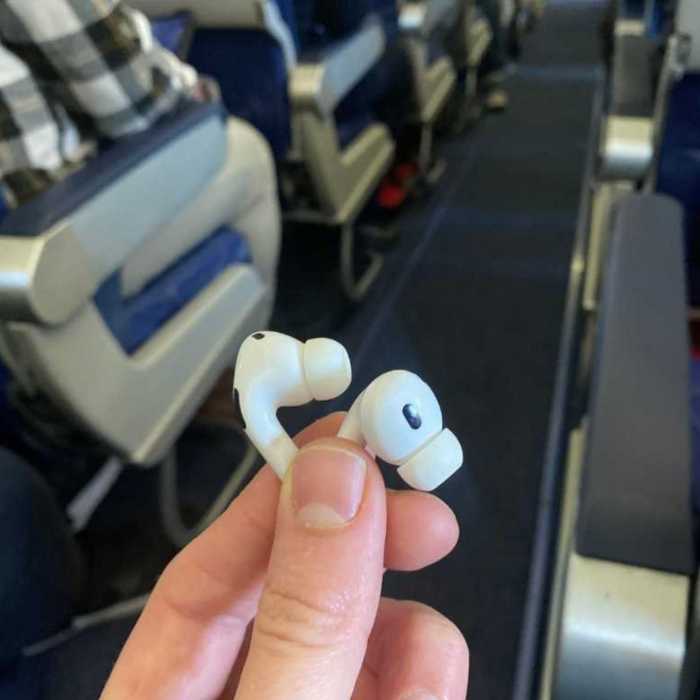
👋 Looking for an OTC hearing for all-day wear? We recommend Sennheiser All Day Clear or Sony CRE-C20.

Key Takeaways:
AirPods won’t fully replace hearing aids, but for those with mild loss or who need a boost situationally, Apple's new feature is fantastic.
AirPod hearing aid functionality is available today through the steps below but will become much easier to access in fall 2024 after Apples software update.
Until apples release, use the steps in this guide to access hearing aid functionality.
To set up hearing AidPods like a hearing aid, you’ll need to sync your hearing test results with Apple Health (we like the Mimi app for this).
Under the ‘Accessiblity’ menu, select ‘AirPod’s and then ‘Accessibility Settings’ and and ‘Headphone Accommodations’ to tune them to your audiogram.
Then, adjust your ‘Transparency Mode’ volume.
Apple sells north of 100M pairs of AirPods every year. Early Apple fans will remember the good old days of free low-tech corded headphones that came with every iPhone.
In 2016 Apple unveiled AirPods, which quickly became a technology staple in coffee shops, airplanes, and Zoom calls.
AirPods have always been a best-in-class true wireless earbud, but in 2019 Apple released AirPods Pro with some more adventurous features, including "Transparency Mode," which lets you hear the world around you through your headphones. Some people pointed out you could use Apple's transparency feature as a bootleg hearing aid.
Then in late 2022, Apple unveiled AirPods Pro 2 with even more powerful noise reduction and amplification features. Apple's keynote never mentioned hearing aids, but the crossover was notable.
As a hearing aid wearer and audio nerd, I wanted to try the new hearing aid features inside AirPods Pro 2 for myself.
In this review, I'll share my experience and step-by-step instructions on how to transform your own AirPods Pro into starter "hearing aids."
Prefer to watch? Here’s my 5 minute breakdown. 👇
How to turn your AirPods Pro 2 into entry-level hearing aids.
All AirPods Pro 2 devices come standard with transparency mode, but the amplification volume is very low and not customized to your hearing loss.
You'll need to take a few steps to get the most out of the hearing features in your AirPods.
#1. Take a hearing test and upload your audiogram.
Every person's hearing loss has a different shape. My hearing gets worse in the middle frequencies and better at low and high frequencies (called a cookie bite). AirPods can compensate for this hearing loss in both streaming and transparency modes, but to unlock that feature, you'll need to take a compatible hearing test.
I suggest you use the Mimi app. Download the app, take the test and sync your results to Apple Health. You can read more about hearing tests here.
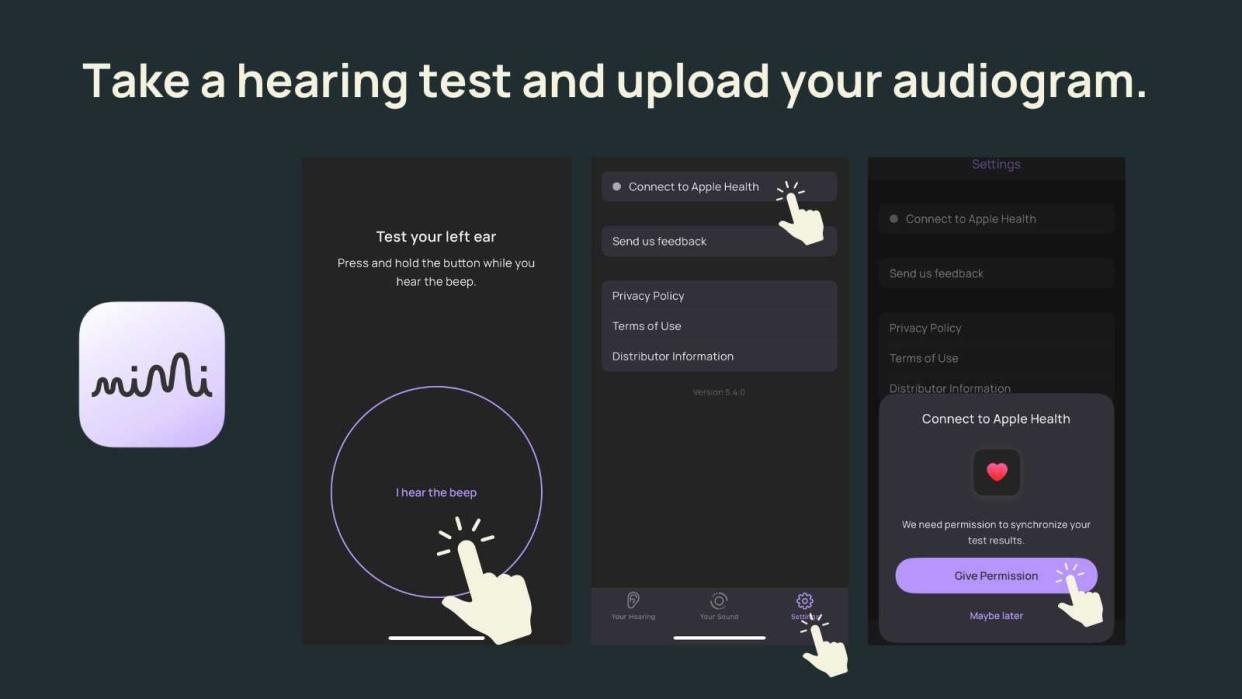
#2. Update audio accessibility settings.
With your audiogram in place, you can now navigate to "Headphone Accommodations" and tune your AirPods to match your audiogram.
Open your settings app > click accessibility > AirPods > audio accessibility settings > headphone accommodations > select "tune audio for audiogram."
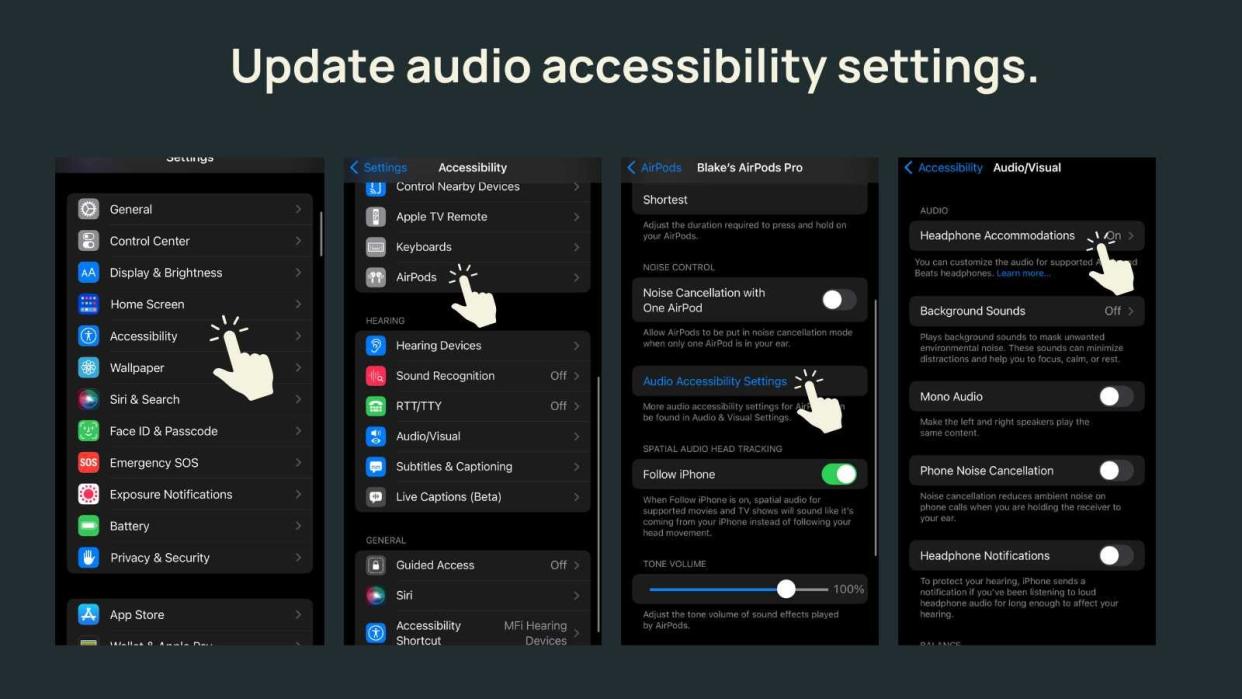
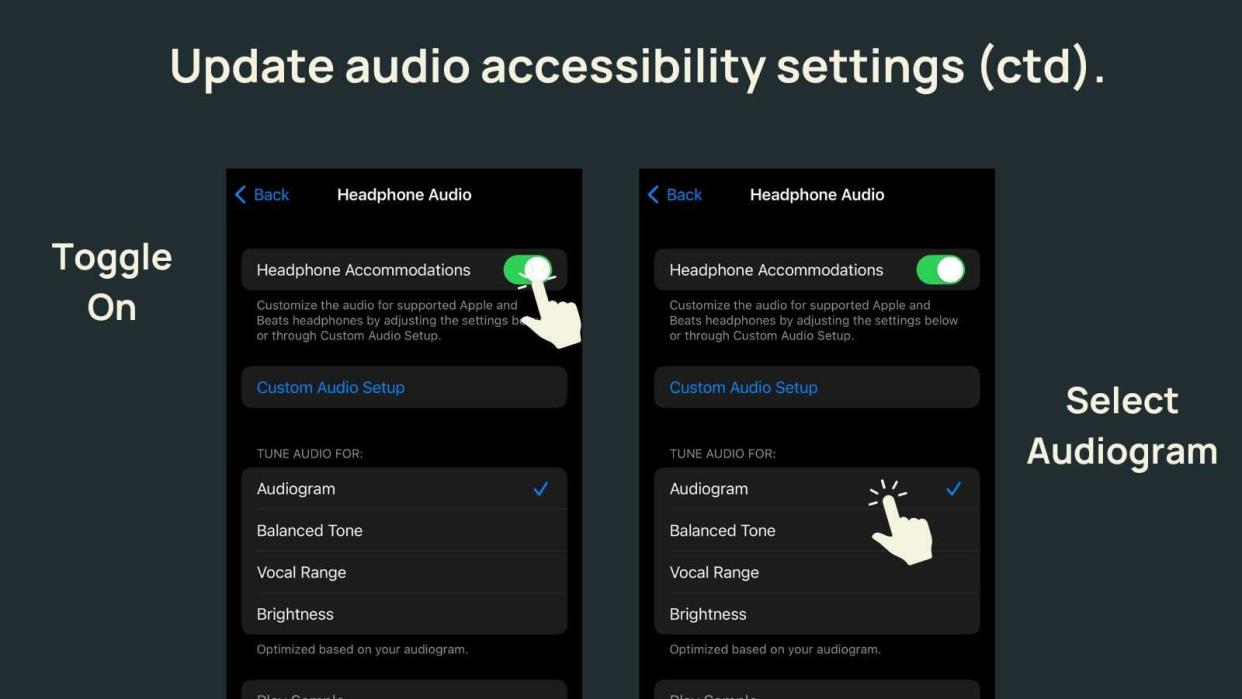
Nice work! Your AirPods Pro 2 are now customizing sound (both transparency and streaming) to match your specific hearing loss shape.
#3. Turn up the transparency mode volume on your AirPods.
AirPods Pro 2 come with built-in Transparency Mode, but the volume isn't loud enough to help most people with hearing loss. Turning up your general phone volume won't help since that only impacts streaming volume and not outside sounds.
Rest assured, turning up the volume of the world around you is just a few clicks away.
Click Settings > Accessibility > Audio/Visual > Headphone Accommodations > Scroll to the bottom of the screen and tap "Transparency Mode"
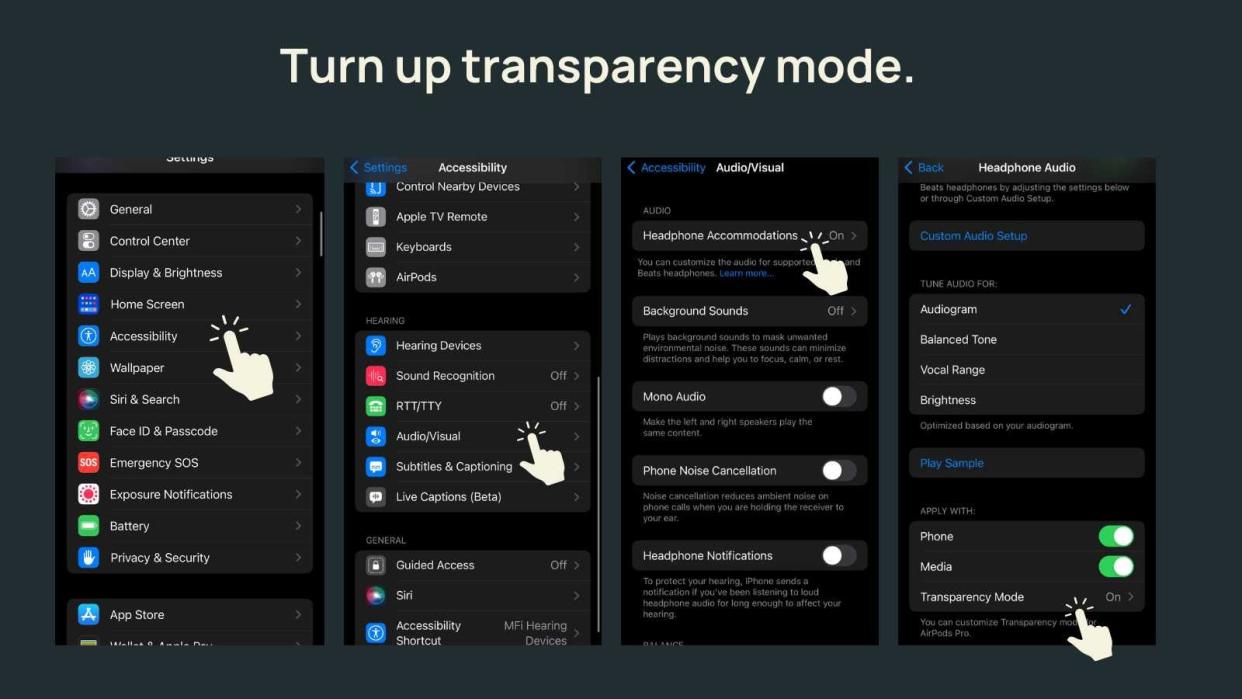
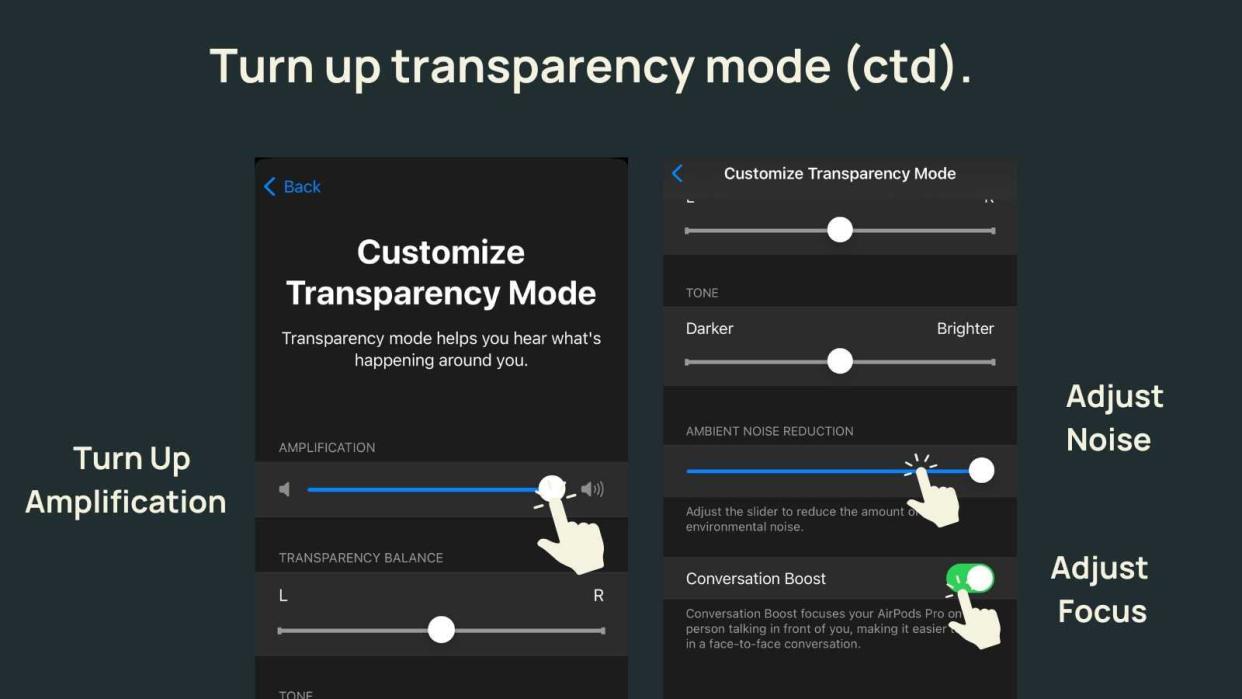
Now you can turn the volume up or down, change the left, right balance (if your hearing is different on each side) and reduce ambient sound.
You can also toggle Conversation Boost on. Conversation Boose focuses your AirPods Pro on the person talking in front of you but results in a slightly less open soundscape.
Play around with your settings until you like the balance. You can always go back and change it later.
That's it. Your Airpod Pro 2 hearing aids are ready for use!
Note: There are some advanced options within AirPods Pro, like personalized spatial audio and an ear tip fit test, but they go beyond the scope of this article.
Limitations of AirPods as hearing aids.
There are some obvious limitations to AirPods Pro as full-fledged hearing aids.
The first is form factor and comfort. I wear my AirPods regularly while working or running, but I can only wear them comfortably for a few hours. Standard hearing aids are much lighter weight and less intrusive in the ear.
The second consideration is social dynamics. I wore my AirPods in transparency mode on a recent trip. When I approached people to ask questions, I could sense them looking to my ears to see whether I was talking to them or on the phone. This dynamic could be even more challenging with friends, colleagues, or family.
The third limitation is sound output. I've maxed out my AirPods Pro 2 transparency mode volume and could still use some additional boost. If you have anything more than mild hearing loss, AirPods probably can't fully replace your amplification needs.
Even with all these limitations in mind, the prospect that Apple (one of the most loved companies in the world) is dabbling in hearing tech is very exciting news.
So are AirPods Pro 2 a hearing aid alternative?
I wore my AirPods Pro 2 devices throughout a day of travel and in a few casual social settings. I also tried them side-by-side with my prescription hearing aids. Some of my reactions:
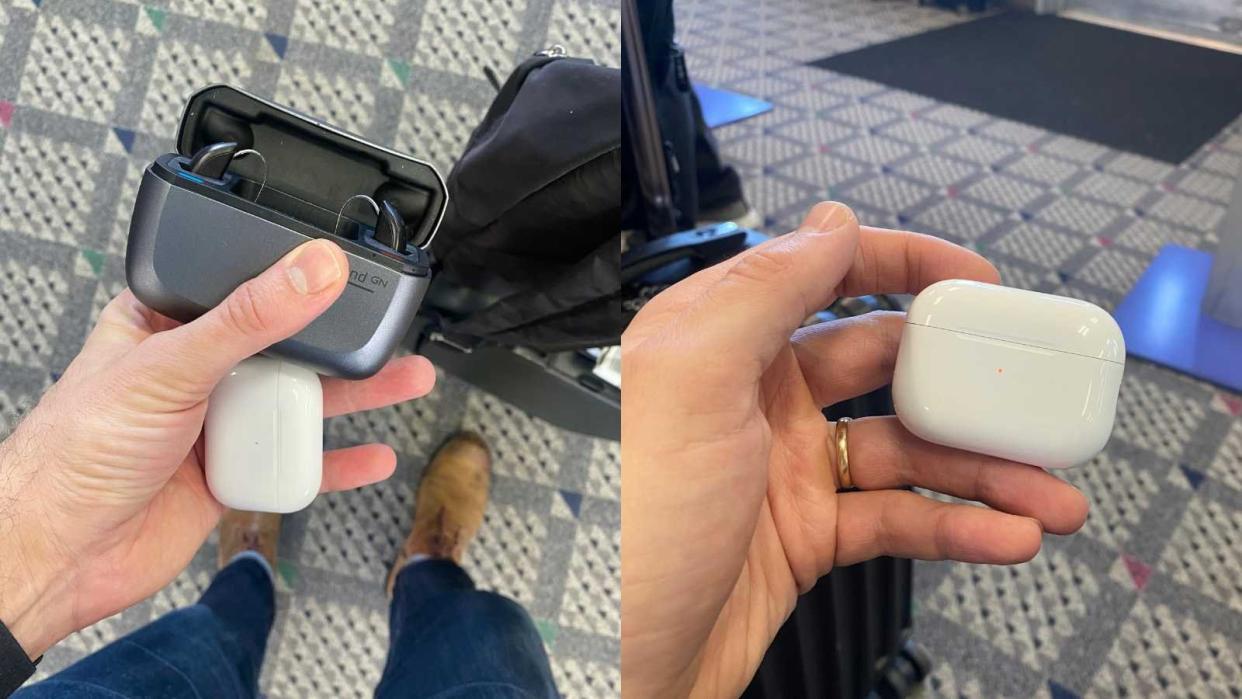
Volume: AirPods don't help without turning the transparency volume way up. Even at max volume, I could have used some more boost.
Clarity: I was impressed with the sound quality and clarity. AirPods are powerful, and they did a great job picking up voices and cutting background noise. I went back and forth between my premium hearing aids and my AirPods, with comparable speech clarity and noise reduction.
Comfort: AirPods aren't comfortable enough to wear all day, but they are fine for a few hours. I'll continue to wear my behind-the-ear style hearing aids day to day.
Form factor: I loved the flexibility of a great earbud with noise cancelation and volume boost during travel, but I won't be wearing my AirPods to dinner with friends anytime soon. The social dynamics would be confusing.
Final Thoughts
Overall I'm impressed! If you or a loved one has mild hearing loss, AirPods could be a good place to dabble with amplification for the first time.
They probably won't replace a pair of proper hearing aids in the long term, but at $249 (with lots of other value), AirPods are a great place to start.
